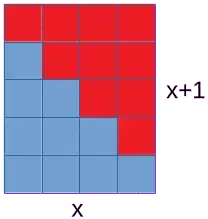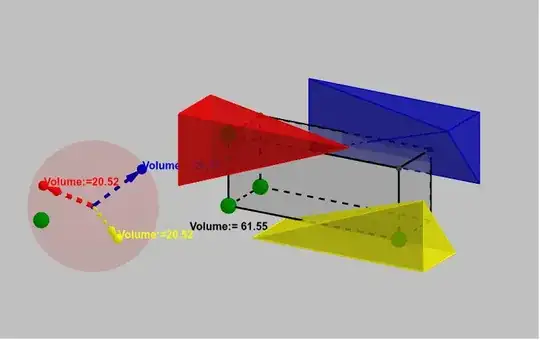Specific question: according to my calculation based on Timbuc's answer to this question,
$$\sum_{k=0}^n\frac{k(k+1)}{2}=\frac{n(n+1)(2n+4)}{12} \\ \;\;\;\;\;\;\;\;\;\;\;\;\;\;\;\;\;\; =\frac{n(n+1)(n+2)}{6}$$
[Edit: RHS simplified based on suggestion from herbsteinberg.]
If this is right, is there an intuitive or geometric proof of this?
Background and motivation: I'm trying to relate the concepts of integration and summation using reasoning which I find simple and intuitive.
As part of that, I'm trying to understand the process of summing sequences in this rotated section of Pascal's triangle:
$(0)\;\;01\;\;01\;\;01\;\;01\;\;01\;\;01\;\;...\frac{k^0}{0!} \\ (1)\;\;01\;\;02\;\;03\;\;04\;\;05\;\;06\;\;...\frac{k+0}{1!} \\ (2)\;\;01\;\;03\;\;06\;\;10\;\;15\;\;21\;\;...\frac{k(k+1)}{2!} \\ (3)\;\;01\;\;04\;\;10\;\;20\;\;35\;\;56\;\;...\frac{k(k+1)(k+2)}{3!}$
I see that summing each line seems to increase the degree of the expression by $1$ and I can imagine that rearrangement, simplification and/or a limit process could later reduce these terms to $\frac{k^2}{2}$, $\frac{k^3}{3}$ etc., but for now I'm interested in how/why each line has the exact expression it does.
Line $(1)$ is just counting.
Line $(2)$ I can picture and understand as in Fig. 1 below.
Fig. 1
Line $(3)$ [Edited to add the following, which may start to answer my question] I can picture and understand as a stepped version of the right-angled tetraga in Fig. 2 below.
Fig. 2

